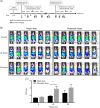PEGylated liposome-encapsulated rhenium-188 radiopharmaceutical inhibits proliferation and epithelial-mesenchymal transition of human head and neck cancer cells in vivo with repeated therapy
- PMID: 30393570
- PMCID: PMC6208374
- DOI: 10.1038/s41420-018-0116-8
PEGylated liposome-encapsulated rhenium-188 radiopharmaceutical inhibits proliferation and epithelial-mesenchymal transition of human head and neck cancer cells in vivo with repeated therapy
Abstract
Human head and neck squamous cell carcinoma (HNSCC) is usually treated with chemoradiotherapy, but the therapeutic efficacy could be hampered by intrinsic radioresistance and early relapse. Repeated administrations of rhenium-188 (188Re)-conjugated radiopharmaceutical has been reported to escalate the radiation doses for better control of advanced human cancers. Here we found that high dosage of 188Re-liposome, the liposome-encapsulated 188Re nanoparticles exhibited significant killing effects on HNSCC FaDu cells and SAS cells but not on OECM-1 cells. To investigate the biological and pharmaceutical responses of high 188Re-liposomal dosage in vivo, repeated doses of 188Re-liposome was injected into the orthotopic tumor model. FaDu cells harboring luciferase reporter genes were implanted in the buccal positions of nude mice followed by intravenous injection of 188Re-liposome. The Cerenkov luminescence imaging (CLI) was performed to demonstrate an increased accumulation of 188Re-liposome in the tumor lesion of nude mice with repeated doses compared to a single dose. Repeated doses also enhanced tumor growth delay and elongated the survival of tumor-bearing mice. These observations were associated with significant loss of Ki-67 proliferative marker and epithelial-mesenchymal transition (EMT) markers in excised tumor cells. The body weights of mice were not significantly changed using different doses of 188Re-liposome, yet repeated doses led to lower blood counts than a single dose. Furthermore, the pharmacokinetic analysis showed that the internal circulation of repeated 188Re-liposomal therapy was elongated. The biodistribution analysis also demonstrated that accumulations of 188Re-liposome in tumor lesions and bone marrow were increased using repeated doses. The absorbed dose of repeated doses over a single dose was about twofold estimated for a 1 g tumor. Together, these data suggest that the radiopharmacotherapy of 188Re-liposome can enhance tumor suppression, survival extension, and internal circulation without acute toxicity using repeated administrations.
Conflict of interest statement
The authors declare that they have no conflict of interest.
Figures






Similar articles
-
Involvement of Differentially Expressed microRNAs in the PEGylated Liposome Encapsulated 188Rhenium-Mediated Suppression of Orthotopic Hypopharyngeal Tumor.Molecules. 2020 Aug 8;25(16):3609. doi: 10.3390/molecules25163609. Molecules. 2020. PMID: 32784458 Free PMC article.
-
Involvement of let-7 microRNA for the therapeutic effects of Rhenium-188-embedded liposomal nanoparticles on orthotopic human head and neck cancer model.Oncotarget. 2016 Oct 4;7(40):65782-65796. doi: 10.18632/oncotarget.11666. Oncotarget. 2016. PMID: 27588466 Free PMC article.
-
Evaluation of the therapeutic and diagnostic effects of PEGylated liposome-embedded 188Re on human non-small cell lung cancer using an orthotopic small-animal model.J Nucl Med. 2014 Nov;55(11):1864-70. doi: 10.2967/jnumed.114.140418. Epub 2014 Oct 27. J Nucl Med. 2014. PMID: 25349220
-
Comparative therapeutic efficacy of rhenium-188 radiolabeled-liposome and 5-fluorouracil in LS-174T human colon carcinoma solid tumor xenografts.Cancer Biother Radiopharm. 2012 Oct;27(8):481-9. doi: 10.1089/cbr.2011.1158. Cancer Biother Radiopharm. 2012. PMID: 23067100
-
Efficacy and Safety of Vincristine Sulfate Liposome Injection in the Treatment of Adult Acute Lymphocytic Leukemia.Oncologist. 2016 Jul;21(7):840-7. doi: 10.1634/theoncologist.2015-0391. Epub 2016 Jun 21. Oncologist. 2016. PMID: 27328933 Free PMC article. Review.
Cited by
-
Nanomaterials as Inhibitors of Epithelial Mesenchymal Transition in Cancer Treatment.Cancers (Basel). 2019 Dec 19;12(1):25. doi: 10.3390/cancers12010025. Cancers (Basel). 2019. PMID: 31861725 Free PMC article. Review.
-
Involvement of Differentially Expressed microRNAs in the PEGylated Liposome Encapsulated 188Rhenium-Mediated Suppression of Orthotopic Hypopharyngeal Tumor.Molecules. 2020 Aug 8;25(16):3609. doi: 10.3390/molecules25163609. Molecules. 2020. PMID: 32784458 Free PMC article.
-
Brachytherapy Approach Using 177Lu Conjugated Gold Nanostars and Evaluation of Biodistribution, Tumor Retention, Dosimetry and Therapeutic Efficacy in Head and Neck Tumor Model.Pharmaceutics. 2021 Nov 9;13(11):1903. doi: 10.3390/pharmaceutics13111903. Pharmaceutics. 2021. PMID: 34834318 Free PMC article.
-
Nanomaterials for the Diagnosis and Treatment of Head and Neck Cancers: A Review.Materials (Basel). 2021 Jul 2;14(13):3706. doi: 10.3390/ma14133706. Materials (Basel). 2021. PMID: 34279276 Free PMC article. Review.
-
Insights into Nanomedicine for Head and Neck Cancer Diagnosis and Treatment.Materials (Basel). 2022 Mar 11;15(6):2086. doi: 10.3390/ma15062086. Materials (Basel). 2022. PMID: 35329542 Free PMC article. Review.
References
LinkOut - more resources
Full Text Sources
Research Materials
Miscellaneous

